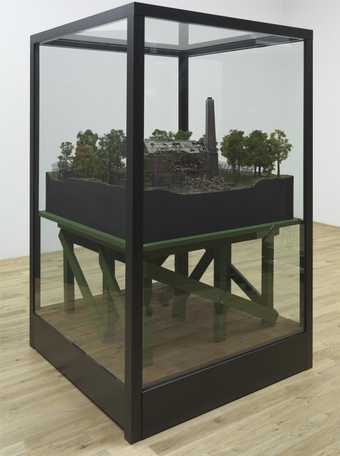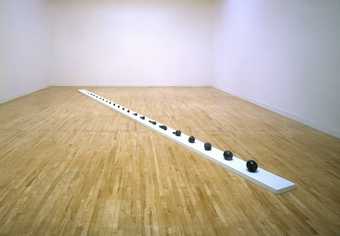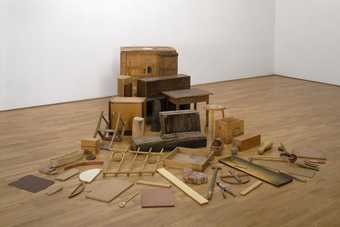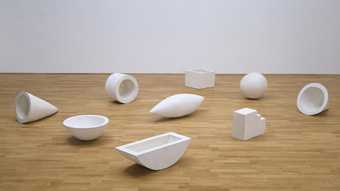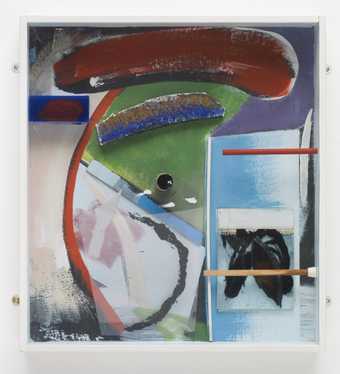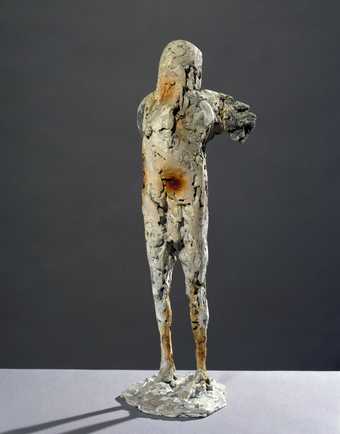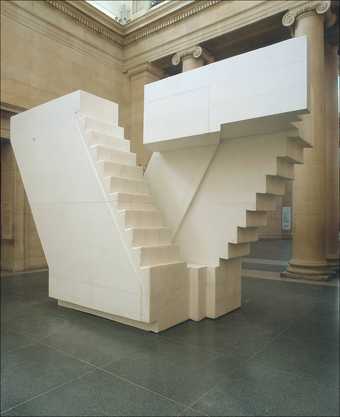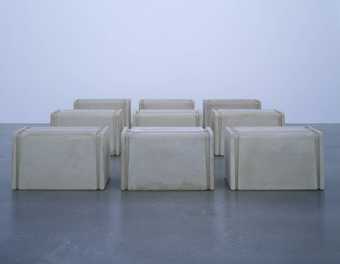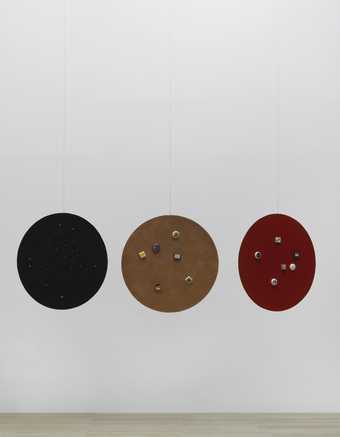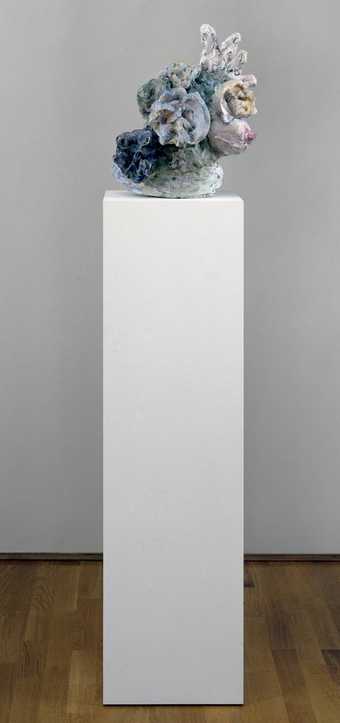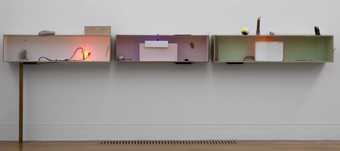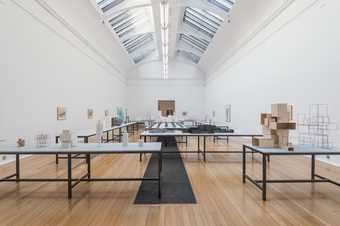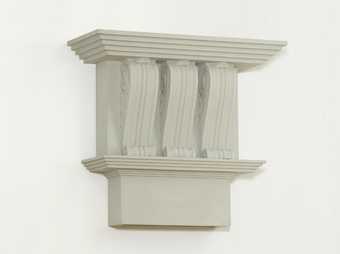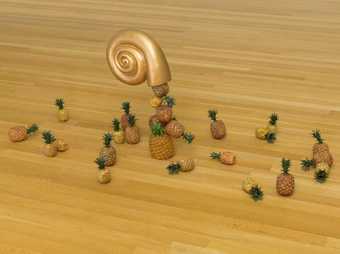
Not on display
- Artist
- Edward Allington 1951–2017
- Medium
- Wood, plastic, polystyrene, plaster and paint
- Dimensions
- Overall display dimensions variable
- Collection
- Tate
- Acquisition
- Presented by the artist's estate 2020
- Reference
- T15560
Summary
Architectural Fragment / Third Column 1986 is a free-standing square-sided column measuring almost two and a half metres in height and made up of fake plastic bricks topped by an Ionic capital roughly rendered in painted plaster. The somewhat loose arrangement of the bricks in the column, with a corresponding ad hoc arrangement of loose bricks and fragments scattered about its base, suggest that it is in the process of being built or would suffer collapse under any weight rather than offer support. The title of the work reflects this as a fragment and as one of an unspecified number of columns; in an earlier work entitled Architectural Fragment from 1984 (collection FRAC, Pays de Loire, France), the artist used the same materials and format though with the column being made of plastic bricks that appear to flow in a swirl from the capital.
Allington was identified – alongside other British artists such as Bill Woodrow, Tony Cragg and Julian Opie, many of whom, like him, were supported by the Lisson Gallery in London – with the emergence of so-called new image sculpture at the end of the 1970s and in the early 1980s, corresponding with the growing prominence of neo-expressionist, new image painting. Their work was characterised by a use of cheap found materials that connected with a contemporary everyday life. This outlook was based on a collage approach, not only of different and contrasting materials but also including a mix of source imagery or style, ideals and principles; within the field of architecture it was signalled by the AT&T Building on Madison Avenue, New York, of 1978–84 by Philip Johnson (1905–2006) – a modernist office building topped by an open pediment design often identified as close to the cabinet maker Thomas Chippendale (1718–1779).
Allington’s Architectural Fragment / Third Column and the related Unsupported Support 1987 (Tate T15561) follow parallel strategies to those that underlaid Johnson’s buildings, and architectural postmodernism more generally. At the root of Allington’s work is his engagement with a clash of traditions and philosophies between classical forms and ideals and the street, an engagement that questions where philosophical or material truth might be recognised. Allington’s sculpture in the 1980s did not simply involve a straightforward collision of different styles and historical periods but was driven by the urge to communicate what the critic Michael Newman identified as ‘a sense of falsity and loss … framed as the degradation of a Classical heritage.’ (Michael Newman, ‘Discourse and Desire, Recent British Sculpture’, Flash Art, no.115, January 1984, pp.54–5.)
Where Allington’s work of the early 1980s communicated this through Dionysian arrangements of plastic fruit and other fake objects spilling from cornucopia or ‘horns of plenty’ – as seen in the sculpture Oblivion Penetrated 1982 (Tate T06895) – from the mid-1980s onwards he turned to the orders of classical architecture in works which present fragments of architectural motifs removed of built function and isolated out of context to convey a similar slippage between truth and falsehood. The displaced architectural fragments indicate a loss of fixity that in turn provided, for Allington, a touchstone for the present condition, at a time when much philosophical and artistic discourse engaged with the idea of ‘simulation’ – the fake and the real could not be identified as such since, in the words of the theorist Jean Baudrillard, simulation ‘bears no relation to reality whatsoever’ (Jean Baudrillard, Simulations, New York 1983, p.11). From such a perspective as this, Allington was involved in an absurdist re-presentation of classical order to underline what he held to be the ‘cultural paradox of the reality of today’ (Edward Allington, untitled statement, on the invitation card for the exhibition Edward Allington, Lisson Gallery, London 1984.)
Architectural Fragment / Third Column was included in the exhibition Edward Allington: Things Unsaid, a retrospective survey of the artist’s work held at the Henry Moore Institute, Leeds from October 2019 to February 2020.
Further reading
Edward Allington, In Pursuit of Savage Luxury, exhibition catalogue, Midland Group Nottingham 1984.
Edward Allington: New Sculpture, exhibition catalogue, Riverside Studios, London 1985.
Edward Allington, exhibition catalogue, Cornerhouse, Manchester 1993.
Andrew Wilson
October 2019
Does this text contain inaccurate information or language that you feel we should improve or change? We would like to hear from you.
Display caption
This sculpture is made of fake plastic bricks. The top is a painted plaster version of an architectural feature which would have been placed at the top of a column in ancient Greece. However, its ambiguous title gives no indication of Allington’s original source. The loose bricks at its base suggest that it is about to collapse or is still being built. For the critic Michael Newman, Allington used ‘the degradation of a classical heritage’ to convey ‘a sense of falsity and loss’.
Gallery label, October 2020
Does this text contain inaccurate information or language that you feel we should improve or change? We would like to hear from you.
You might like
-
Dinos Chapman, Jake Chapman Arbeit McFries
2001 -
Sir Antony Gormley OBE RA Natural Selection
1981 -
Tony Cragg Axehead
1982 -
Edward Allington Ideal Standard Forms
1980 -
Peter Lanyon Turn Around
1963–4 -
Dame Elisabeth Frink Bird Man
c.1966 -
Rachel Whiteread Untitled (Stairs)
2001 -
Rachel Whiteread Untitled (Nine Tables)
1998 -
Li Yuan-chia Hanging Disc Toy
c.1980 -
Rebecca Warren OBE Versailles
2006 -
Rebecca Warren OBE In The Bois
2005 -
Sir Antony Gormley OBE RA The Model Room
1994–2013 -
Edward Allington Unsupported Support
1987 -
Edward Allington From the Birth of Paradise
1983 -
Mike Nelson Amnesiac Beach Fire (from Master of Reality)
1997

